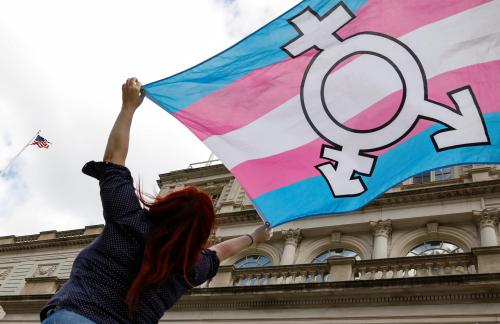On February 8, an Oklahoma transgender teen named Nex Benedict died. While an exact cause of death has yet to be determined, we know that Nex was involved in a violent altercation with three girls in a girls’ bathroom at Owasso High School. The next day, Nex died. (According to reporting from NBC News, Nex identified as transgender and preferred he/him pronouns, but also used they/them pronouns.)
We also know from Nex’s family and friends that Nex experienced routine bullying and harassment at school because of his transgender identity—as did other LGBTQ+ youth according to a number of media accounts. What’s more, this harassment is taking place in a state where anti-LGBTQ+ legislation and rhetoric has proliferated in recent years. In 2022, Governor Kevin Stitt signed into law requirements that prevent trans youth from using the bathroom that matches their gender identity. (Nex’s mother said in a recent interview that the bullying Nex experienced intensified after the Oklahoma bathroom bill went into effect). What’s worse, Oklahoma’s state superintendent of education has vehemently attacked any efforts to make schools more inclusive for LGBTQ+ youth and is on the record stating his belief that transgender and nonbinary people do not exist.
On March 1, 2024, the U.S. Department of Education’s Office for Civil Rights (OCR) announced that it was launching an investigation into Owasso Public Schools over concerns that the district failed to adequately respond to allegations of sex-based harassment (under Title IX of the Education Amendments of 1972, which prohibits discrimination on the basis of sex). The investigation was opened in response to a civil rights complaint filed by the Human Rights Campaign (HRC)—an LGBTQ+ advocacy group.
In this post, I’ll outline what happens once OCR opens a new investigation, what I’m hoping to see from this investigation in particular, and why I’m ultimately skeptical of this enforcement tool as a lever for bringing about meaningful change.
What does it mean that OCR opened an investigation?
OCR enforces Title IX and other federal civil rights laws in publicly funded educational institutions—including all K-12 public schools. The agency’s primary enforcement tool is investigations into potential civil rights violations. Most investigations are opened in response to civil rights complaints received by the agency.
The bar for OCR to investigate a civil rights complaint is low. And that’s by design. OCR’s civil rights complaint process is intended to be a low-cost avenue available to parents, families, and community advocates concerned about potential violations in public schools—one that does not require hiring legal representation to pursue. But that also means we should not read too much meaning into the fact that ED opened a new investigation. OCR opening an investigation does not mean federal officials suspect that a civil rights violation took place. It only means that a complaint alleging a form of discrimination enforceable (in this case, Title IX) by OCR was made in a timely manner.
What happens once an investigation is opened?
The goal of an OCR investigation is to determine whether an alleged civil rights violation took place and to decide what district reforms are appropriate based on what the investigation uncovered. In practice, the scope and scale of OCR investigations varies widely. Sometimes OCR conducts large-scale investigations that include multiple site visits and meetings with a wide variety of stakeholders. Other times, OCR interviews only a few stakeholders alongside a review of extant documents and data. When and why OCR deploys more investigatory resources are unknown, but that means it is difficult to predict exactly what shape this investigation into Owasso Public Schools will take.
It is also unclear how far-reaching this investigation will be. In some cases, OCR only investigates allegations related to the specific incident outlined in the complaint. In other words, were Nex’s civil rights violated by Owasso Public Schools? In others, OCR investigators interrogate whether the alleged incident is one part of a broader pattern of civil rights abuses taking place. In other words, are LGBTQ+ students’ civil rights routinely violated in Owasso Public Schools? These differences may seem subtle but are hugely consequential for the ultimate scope of the investigation and the scale of any proposed district reforms.
OCR’s letter notifying HRC that an investigation was being opened seems to imply the latter approach—stating that OCR will investigate “whether the District failed to appropriately respond to alleged harassment of students” [emphasis added]. This is critical if OCR aims to address the conditions that led to the harassment and bullying that Nex experienced, especially considering reports of numerous other instances of harassment of LGBTQ+ youth in Owasso Public Schools.
It is also important to underscore that OCR is one relatively small federal agency that has not been adequately staffed or funded for at least the last two decades. This has become an acute challenge over the last several years as OCR’s caseload has exploded and as Assistant Secretary Catherine Lhamon has prioritized more systemic investigations. The consequence of this reality is that investigations can take years, and still not be particularly thorough. At best, an investigation like this could take less than a year. At worst, it could be several years before it is resolved.
What should happen next?
Most OCR investigations are not instigated by an incident as tragic as this one. It is imperative that OCR investigators handle this case with care. At minimum, that should include careful engagement with Nex’s family and friends (to the extent they wish to be involved), along with other members of the school’s LGBTQ+ community.
Hearing directly from LGBTQ+ students is also critical considering Owasso Public Schools’ initial response to news of the investigation. Per an official statement, while the district intends to cooperate with federal investigators, it “believes the complaint submitted by H.R.C. is not supported by the facts and is without merit.” Initial reporting also reflects inconsistencies between what Nex’s family and friends said took place, versus the school district and the police departments’ official accounts. Moreover, Oklahoma’s state superintendent, Ryan Walters, has publicly denied that Nex’s death had anything to do with his gender identity even as the criminal investigation into Nex’s death remains ongoing.
This context underscores how important it is that OCR works to draw its own conclusions about the bullying and harassment of Nex and other LGBTQ+ students in Owasso Public Schools rather than relying on conclusions drawn by the district and police department.
What might come of this investigation?
In theory, if a school district is found in violation of civil rights law, OCR can rescind federal funding or have the case referred to the Department of Justice for further judicial action.
In practice, findings of civil rights violations are exceedingly rare. Most investigations that lead to mandated reforms are resolved through negotiations between OCR and a district. OCR’s policies favor negotiated settlements over more forceful enforcement actions at every step of the investigation process. Thus, unless a school district is blatantly and repeatedly refusing to cooperate with OCR, the likelihood of some penalty for violating civil rights law is very small.
The agency’s preference for negotiating with districts also means that the resulting resolution agreements often include reforms that seem mild, at best, and wildly insufficient, at worst. Take, for example, a recent resolution agreement OCR entered into with Rhinelander Public Schools in Wisconsin. This case, like the Owasso investigation, involved persistent harassment of a gender non-conforming student by some teachers and students and a district’s repeated failure to adequately respond. In the negotiated settlement, the district agreed to 1) assess whether compensatory instructional time was owed to the harassed student; 2) provide trainings to both staff and high school students on what constitutes sex-based harassment under Title IX and the district’s Title IX grievance process; 3) improve how it documents accusations of sex-based harassment; 4) conduct a school climate survey “to assess the prevalence of sex-based harassment and obtain suggestions for effective ways to address harassment.”
Of these actions, only one was directly aimed at improving the school environment for LGBTQ+ students–mandatory trainings for staff and high school students. Putting aside the fact that OCR’s standard Title IX reforms seem insufficient to remedy widespread harassment of LGBTQ+ students—especially in a state where the top education official’s anti-LGBTQ+ biases are on full display, a large body of evidence indicates that these types of one-off anti-discrimination or diversity trainings are often ineffective.
Thus, unless OCR officials take a radically different approach in this case (which I hope they do given the gravity of the incident), the outcomes of this investigation are–unfortunately—unlikely to bring about significant reforms in Owasso Public Schools.
What can ED do to prevent discrimination against LGBTQ+ students?
The Biden administration’s long-awaited and much delayed updated Title IX regulations are expected to be released next month. This overhaul of Title IX is notable for several reasons, including that it codifies the Department’s interpretation that Title IX protections extend to discrimination based on gender identity and sexual orientation.
The pending adoption of the new Title IX regulations is particularly important in this case because in July 2022 a federal judge in Tennessee temporarily blocked ED from enforcing its new interpretation of Title IX after 20 conservative states—including Oklahoma—filed a lawsuit to stop its enforcement. This meant that OCR’s ability to enforce this more expansive interpretation of Title IX had been severely limited until the new regulations were formally in place.
This is not to say that updated Title IX regulations alone will be sufficient, and they will undoubtedly be challenged in federal court as Republican lawmakers and attorneys general have made clear. But its delays have led to an environment where districts must choose between complying with state law or federal guidance and where the rights of LGBTQ+ students remain painfully unclear—and in lots of states, including Oklahoma, under attack.
The Brookings Institution is committed to quality, independence, and impact.
We are supported by a diverse array of funders. In line with our values and policies, each Brookings publication represents the sole views of its author(s).








Commentary
The U.S. Department of Education is investigating Nex Benedict’s Oklahoma school district: What happens next?
March 8, 2024